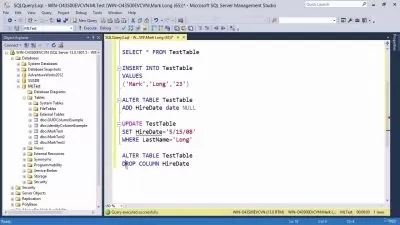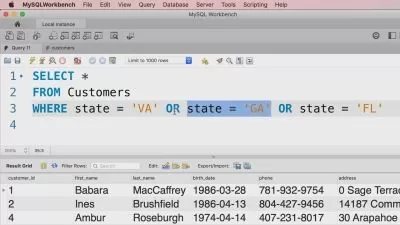TutorialD for SQL Developers
30:56
Description
What happens if we reimagine SQL from first principles?
What You'll Learn?
- Understand how SQL does not faithfully represent the relational algebra
- Learn to use an alternative to SQL: TutorialD
- Examine an alternative relational database management system: Project:M36
- Understand the value of adhering to mathematical principles in the software space
Who is this for?
What You Need to Know?
More details
DescriptionHave you been bitten by the odd quirks of SQL and wondered if there could be something better? There is- it's called "TutorialD" which strictly adheres to the mathematics of the relational algebra.
This course answers questions such as:
is it possible to design a database without NULLs?
how does SQL deviate from the relational algebra?
what would an SQL alternative look like and why?
what do we gain by replacing SQL with a different language?
TutorialD is not merely a hypothetical language, but one implemented by Project:M36, a relational algebra engine, which is open-source software which can be downloaded and used for free. Using Project:M36, you will be able to experiment with the new TutorialDÂ language and build real databases of your own. Docker is required to run Project:M36.
By the end of this course, you will be aware of the flaws in SQL and how such flaws can reduce the confidence in your query results. At the same time, you will understand how SQL's flaws and historical baggage are not essential complexity of database systems, as proven by the alternative language: TutorialD.
This course is recommended for technologists already familiar with basic SQL who are curious about alternative database languages.
Who this course is for:
- Programmers who are curious about alternatives to SQL
Have you been bitten by the odd quirks of SQL and wondered if there could be something better? There is- it's called "TutorialD" which strictly adheres to the mathematics of the relational algebra.
This course answers questions such as:
is it possible to design a database without NULLs?
how does SQL deviate from the relational algebra?
what would an SQL alternative look like and why?
what do we gain by replacing SQL with a different language?
TutorialD is not merely a hypothetical language, but one implemented by Project:M36, a relational algebra engine, which is open-source software which can be downloaded and used for free. Using Project:M36, you will be able to experiment with the new TutorialDÂ language and build real databases of your own. Docker is required to run Project:M36.
By the end of this course, you will be aware of the flaws in SQL and how such flaws can reduce the confidence in your query results. At the same time, you will understand how SQL's flaws and historical baggage are not essential complexity of database systems, as proven by the alternative language: TutorialD.
This course is recommended for technologists already familiar with basic SQL who are curious about alternative database languages.
Who this course is for:
- Programmers who are curious about alternatives to SQL
User Reviews
Rating

Udemy
View courses Udemy- language english
- Training sessions 48
- duration 30:56
- Release Date 2024/10/31









